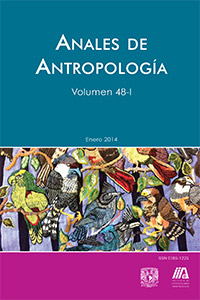Feeding of the prehispanic maya from the view of zooarchaeology
Main Article Content
Abstract
The present article reviews pre-Columbian Maya diet from three different angles: the taxonomic profile of the presumably consumed animals, the relationship between agriculture/ecology and animal hunting in the surroundings of the settlements, and finally, the reconstruction of some aspects of the maya cuisine, based on zooarchaeological and taphonomic evidence. The first part of the text presents lists of vertebrate animals that are presumed to have formed part of the maya diet because their remains were found in middens associa-ted with residential structures. Throughout the maya area taxonomic studies emphasize the white tailed deer (Odocoileus virginianus) as one of the species most widely and frequently found in archaeological deposits. Also, the use of a relatively narrow range of taxa that are consistently found at most pre-Columbian sites allows us to relate the hunt of those animals to land use and transformation in the maya environment. Corn cultivation appears to have led tothe increased presence of certain taxa that were important to the ancient maya diet. Lastly, the marks on the faunal bones excavated from these middens allow us to hypothesize about early evidence for a traditional cooking method, the píib, possibly used since pre-Columbian times.
Downloads
Article Details
Citas en Dimensions Service
Esta revista usa una licencia CC del tipo CC BY-NC-ND 3.0. Se maneja bajo el esquema de acceso abierto, con una licencia Creative Commons Attribution-NonCommercial-NoDerivs 3.0 Unported.
